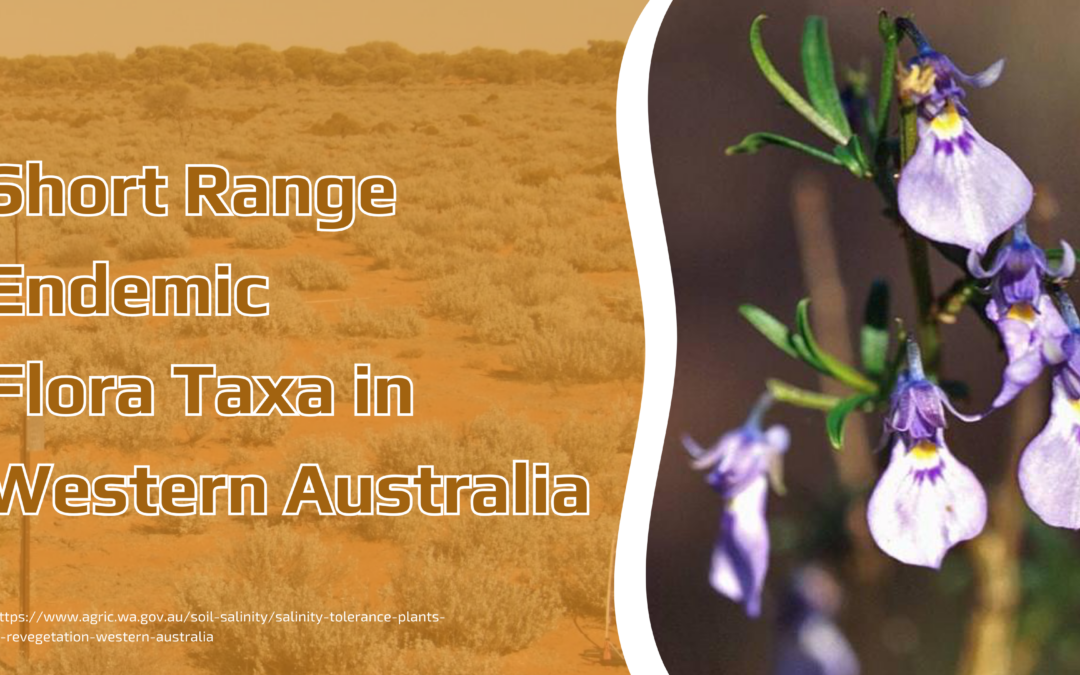An endemic species is only found in a single geographic location, such as an island, country, state, bioregion, or subregion (Iberdrola, 2024). The extent of this geographic location is referred to as the species range. When the range is restricted to less than 10,000km2, the species may be described as a Short-Range Endemic (SRE) (Cochrane, 2018). The term SRE is typically used to describe invertebrate fauna species such as spiders, scorpions, millipedes, etc. (Mason, Bateman, & Wardell-Johnson, 2018) however, it is also relevant for flora species.
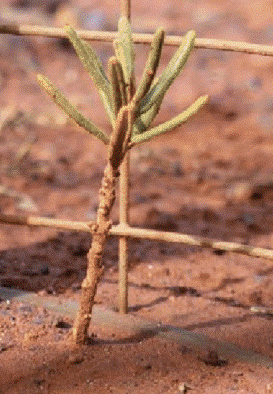
(Elliott, Wilkinson, & Turner, 2018)
SRE flora species are commonly found in old, stable landscapes (Mason, Bateman, & Wardell-Johnson, 2018). These landscapes have experienced prolonged weathering or erosion with limited to no rejuvenation, leading to nutrient-poor soils (Mucina & Wardell-Johnson, 2011). Rejuvenation may occur through floods, earthquakes, landslides, fires, cyclones and fauna burrowing, which turns the soil over. An example of an old, stable landscape is Windarling Range, a banded iron formation approximately 200km west of Kalgoorlie (DCCEEW, 2010). The Windarling Range has experienced weathering over a prolonged period (Gibson, Coates, & Thiele, 2007) and is where Ricinocarpos brevis (Figure 1) is found. Ricinocarpos brevis is an endangered shrub with white flowers restricted to a 1,700km2 range within the Windarling Range area (Halford & Henderson, 2007). It is found in shallow sandy soils at an elevation of 500 and 550m above mean sea level (AMSL).
Potential Reasons for Species’ Small Range
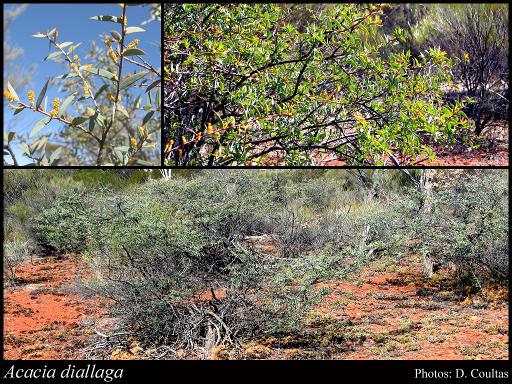
(Western Australian Herbarium, 2024)
Some landscapes appear contiguous but contain barriers that limit a species’ range (Tomlinson, Lewandrowski, Elliott, Miller, & Turner, 2020). These barriers could be water availability, soil water content, soil composition, light and shade or the presence of breakages in rocks (Robinson, Virgilio, D Temple-Smith, & Wardell-Some landscapes appear contiguous but contain barriers that limit a species’ range (Tomlinson, Lewandrowski, Elliott, Miller, & Turner, 2020). These barriers could be water availability, soil water content, soil composition, light and shade or the presence of breakages in rocks (Robinson, Virgilio, D Temple-Smith, & Wardell-Johnson, 2019). For instance, the Priority 1 species Acacia diallaga (Figure 2), a 1.5m shrub with yellow flowers found in the Midwest Region of Western Australia, 315km northwest of Perth (Maslin & Buscumb, 2008). Other acacia species are present in the Midwest Region; however, Acacia diallaga is only found on the slopes and occasionally on the crests of low rocky hills. Bui, Gonzalez-Orozco & Miller (2014) determined the species is associated with high magnesium soils similar to other SRE plants in the region. Potentially, Acacia diallaga requires magnesium for its growth, or it provides a competitive advantage (Tomlinson, Lewandrowski, Elliott, Miller, & Turner, 2020).
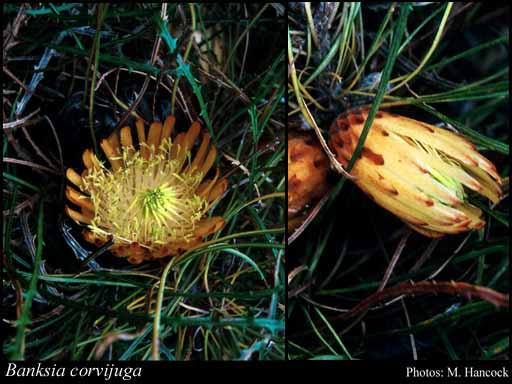
(Western Australian Herbarium, 2023)
A landscape with an SRE can also include areas considered suitable for the species, but it doesn’t occur there (Robinson, Virgilio, D Temple-Smith, & Wardell-Johnson, 2019). This could be due to the species’ dispersal method or required species interactions limiting its dispersal (Cochrane, 2018). For instance, Banksia corvijuga (formerly known as Dryandra corvijuga) (Figure 3), a Priority 3, 1m tall shrub with yellow flowers (Western Australian Herbarium, 2023), occurs in the Ravensthorpe area 550km south-east of Perth (Markey, Kern, & Gibson, 2012). In this area, the species is found on the northern and central ridges between 230 to 440m altitude but not on the south-eastern side at 110 to 280m altitude. The north and south ridges are similar; both are dominated by eucalyptus species with a banksia species understory, and their soil consists of sandy loams (Markey, Kern, & Gibson, 2012). However, the north and central ridges contain Banksia cirioides and Banksia pallida in their understory, which are not present on the south-eastern ridge; potentially, these banksia species influence Banksia corvijuga’s distribution.
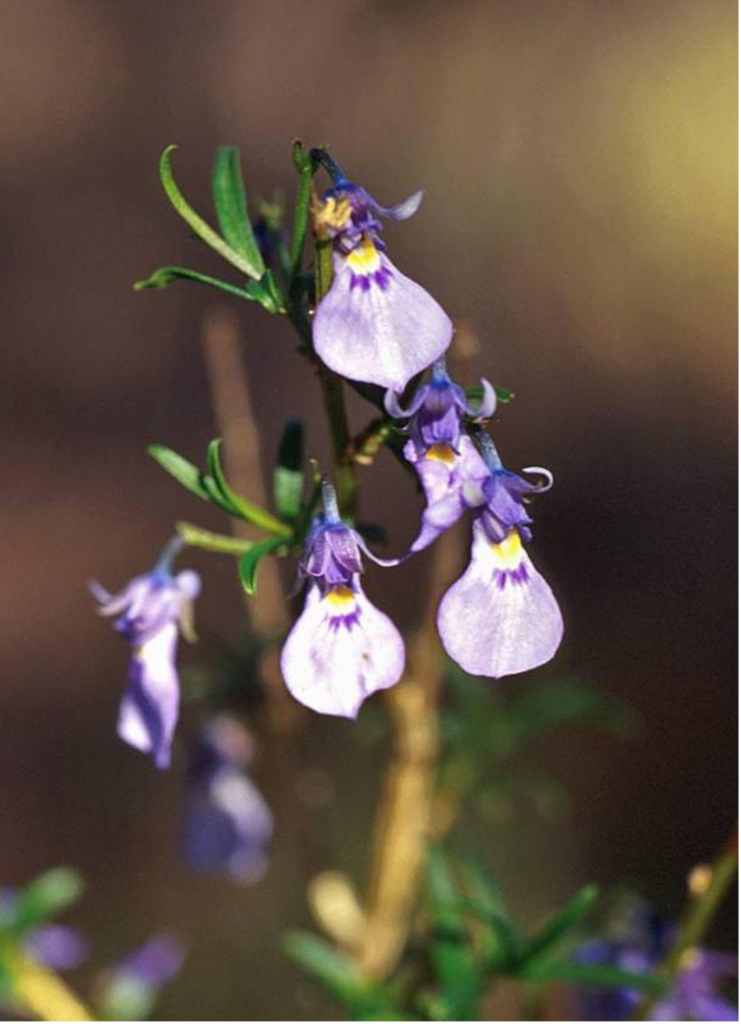
(Fame, 2021)
Conservation Difficulties
Flora species considered an SRE have a small range, low reproduction rate and small dispersal area, which can make conservation activities difficult (Mason, Bateman, & Wardell-Johnson, 2018). Typically, conservation efforts involve creating nature reserves around the population to reduce threats (DPLH, 2023). However, when the population is considered small and vulnerable, conservation also involves identifying new populations, establishing insurance populations, or translocating the population to a similar habitat (Tomlinson, Lewandrowski, Elliott, Miller, & Turner, 2020). Due to their very specific requirements, these targeted efforts can be challenging to undertake for SREs (Mason, Bateman, & Wardell-Johnson, 2018). For example, Pigea cymulosa (formerly known as Hybanthus cymulosus) (Figure 4) is a 0.9m critically endangered herb in the Mt Singleton area (DCCEEW, 2009); it is found along drainage lines and gullies on a series of hills in a range of 140km2 but is believed to occupy only 1km2 within this range. A recovery plan has been created for the species (DEC, 2009) however, with little known about its habitat requirements, traditional conservation activities are difficult to apply. Instead, the plan focused on reducing threats to the known populations, such as grazing from feral goats.
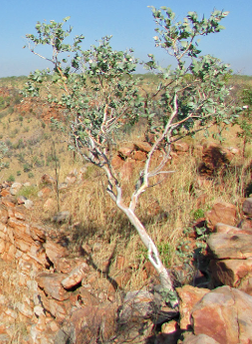
(Nicolle & Barrett, 2018)
Conservation difficulties can also occur from a lack of knowledge due to the SRE being in a remote location that is hard to access. An example is Eucalyptus mooreana (Figure 5), a Priority 4, 9m tall tree found in the King Leopold Ranges in the Kimberly region (DCCEEW, 2008). It is found on the sandy soils at the summits of the range (DCCEEW, 2008), which makes accessing the species for research difficult (Nicolle & Barrett, 2018). Despite this, specimens were first collected in 1914, and further specimens showed two variants: one with a powdery coating and one without. Nicolle & Barrett (2018) later discovered the non-powdery variant was a new species called Eucalyptus revelata (Figure 6). The species is a 4m tree that covers a similar area in the King Leopold Ranges as Eucalyptus mooreana, and is classified as Priority 2 and requires more research.
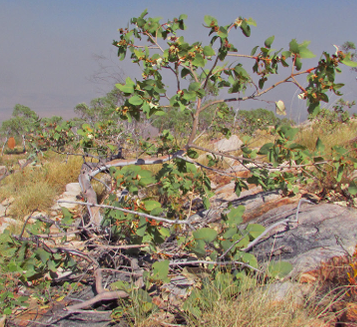
(Nicolle & Barrett, 2018)
Integrate Sustainability Pty Ltd understands the threats to Short-Range Endemic species; if your company needs to understand its obligations relating to Short Range Endemic flora and fauna, please call us on 08 9468 0338 or email us at enquiries@integratesustainability.com.au.
References
Bui, E., Gonzalez-Orozco, C., & Miller, J. (2014). Acacia, climate and geochemistry in Australia. Plant Soil, 381, 161-175. doi:10.1007/s11104-014-2113-x
Cochrane, A. (2018). Temperature thresholds for germination in 20 short-range endemic plant species from a Greenstone Belt in southern Western Australia. Plant Biology, 22, 103-112. doi:10.1111/plb.12951
DCCEEW. (2008). Approved conservation advice for Eucalyptus mooreana (Mountain White Gum). Department of Climate Change, Energy, Environment and Water.
DCCEEW. (2009). Approved conservation advice for Hybanthus cymulosus (Ninghan Violet). Department of Climate Change, Energy, Environment and Water.
DCCEEW. (2010). Approved conservation advice for Ricinocarpos brevis.
DEC. (2009). Ninghan Violet (Hybanthus cymulosus) interim recovery plan 2009-2014. Perth, Western Australia: Department of Environment and Conservation.
DPLH. (2023). Crown land reserves. Retrieved from Government of Western Australia: https://www.wa.gov.au/organisation/department-of-planning-lands-and-heritage/crown-land-reserves
Elliott, C., Wilkinson, K., & Turner, S. (2018). Threatened plant translocation case study: Ricinocarpos brevis, Euphorbiaceae. Australasian Plant Conservation, 26(4), 12-15. doi:10.5962/p.373734
Fame. (2021). #ThreatenedThursday: Ninghan Violet. Retrieved from https://www.fame.org.au/news/ninghan-violet-threatened-thursday
Gibson, N., Coates, D., & Thiele, K. (2007). Taxonomic research and the conservation status of flora in the Yilgarn Banded Iron Formation ranges. Nuytsia, 17, 1-12. Retrieved from https://doi.org/10.58828/nuy00521
Halford, D., & Henderson, R. (2007). A taxonomic revision of Ricinocarpos Desf. (Euphorbiaceae: Ricinocarpeae, Ricinocarpinae). Austrobaileya, 7(3), 387-449. Retrieved from https://www.jstor.org/stable/41739052
Markey, A., Kern, S., & Gibson, N. (2012). Floristic communities of the Ravensthorpe Range, Western Australia. Conservation Science Western Australia, 8(2), 187-239. Retrieved from https://www.researchgate.net/publication/286978068_Floristic_communities_of_the_ravensthorpe_range_western_australia
Maslin, B., & Buscumb, C. (2008). Acacia diallaga (Leguminosae: Mimosoideae), a new geographically restricted species with diallagous phyllodes from the Midwest Region of south-west Western Australia. Nuytsia, 18, 127-132. Retrieved from https://florabase.dbca.wa.gov.au/science/nuytsia/539.pdf
Mason, L., Bateman, P., & Wardell-Johnson, G. (2018). The pitfalls of short-range endemism: High vulnerability to ecological and landscape traps. PeerJ, 6. doi:10.7717/peerj.4715
Mucina, L., & Wardell-Johnson, G. (2011). Landscape age and soil fertility, climatic stability, and fire regime predictability: Beyond the OCBIL framework. Plant and Soil, 341, 1-23. doi:10.1007/s11104-011-0734-x
Nicolle, D., & Barrett, R. (2018). Eucalyptus revelta, a rare new species related to E. mooreana (Myrtaceae) from the Kimberly region of Western Australia. Nuytsia, 29, 109-118. Retrieved from https://doi.org/10.58828/nuy00873
Robinson, T., Virgilio, G. D., D Temple-Smith, J. H., & Wardell-Johnson, G. (2019). Characterisation of range restriction amongst the rare flore of Banded Ironstone Formation ranges in semiarid south-western Australia. Australian Journal of Botany, 67, 234-247. Retrieved from https://doi.org/10.1071/BT18111
Tomlinson, S., Lewandrowski, W., Elliott, C., Miller, B., & Turner, S. (2020). High-resolution distribution modeling of a threatened short-range endemic plant informed by edaphic factors. Ecology and Evolution, 10(2), 763-777. Retrieved from https://doi.org/10.1002/ece3.5933
Western Australian Herbarium. (2023). Banksia corvijuga (A.S.George) A.R.Mast & K.R.Thiele. Retrieved from FloraBase: https://florabase.dbca.wa.gov.au/browse/profile/32617
Western Australian Herbarium. (2024). Acacia diallaga Maslin & Buscumb. Retrieved from FloraBase: https://florabase.dbca.wa.gov.au/browse/profile/31925

